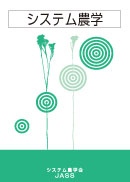All issues

Volume 13 (1997)
- Issue 2 Pages 73-
- Issue 1 Pages 1-
Volume 13, Issue 1
Displaying 1-4 of 4 articles from this issue
- |<
- <
- 1
- >
- >|
Contributed paper
-
Teruaki Nanseki, Hiroshi Naganoma, Atsushi Oyanagi, Shiro Tsuchida1997Volume 13Issue 1 Pages 1-9
Published: April 10, 1997
Released on J-STAGE: January 05, 2024
JOURNAL OPEN ACCESSIn this paper, an estimation method of possible farm operation time for rice-wheat-soybean farming system by hourly precipitation data is opposed. Possible farm operation time by major operation category for the farming system is also estimated by this method. It is verified that the estimation method is appropriate and useful by comparing the estimated possible farm operation time from the actual operation time of harvesting of rice in the study site in past two year. The estimation of past ten years in Ibaraki Prefecture makes it clear that possible farm operation time of rice, wheat and soybean is a major factor of the increase of the farm scale and is unstable in terms of yearly variation.View full abstractDownload PDF (704K) -
(2) Phosphorus and Potasium FlowMikinori Tsuiki, Yasuo Harada1997Volume 13Issue 1 Pages 10-16
Published: April 10, 1997
Released on J-STAGE: January 05, 2024
JOURNAL OPEN ACCESSAs livestock production in Japan becomes more intensive, livestock wastes cause serious environmental problems. To obtain fundamental data for solving these problems, phosphorus(P) and potassium(K) flows in dairy farms were estimated quantitatively. The nutrient flow system in dairy farms consists of ten parts; chemical fertilizer, self-supplying feed, purchased feed, produced milk, sold cattle, beddings, wastes and manure (sold, used for their own croplands and unknown). The estimated amounts of nutrients in cattle wastes were 469kgP/farm/year and 3,775kgK/farm/year in 1985, 641kgP/farm/year and 5,226kgK/farm/year in 1990 in Hokkaido, and 249kgP/farm/year and 1,596kgK/farm/year in 1985, 315kgP/farm/year and 2,130kgK/farm/year in 1990 in the areas except Hokkaido. In Hokkaido, about 48.5kgP/ha/year (1985: 50.4kgP/ha/year, 1990: 46.5kgP/ha/year) and 195kgK/ha/year (1985: 194kgK/ha/year, 1990: 196kgK/ha/year) were applied for their own croplands as cattle manure and chemical fertilizer. In the areas except Hokkaido, about 86.2kgP/ha/year (1985: 84.6kgP/ha/year, 1990: 87.7kgP/ha/year) and 448kgK/ha/year (1985: 416kgK/ha/year, 1990: 479kgK/ha/year) were applied for their own croplands as cattle manure and chemical fertilizer. The differences between loadings onto croplands and removed by forage crops were about +32.9kgP/ha/year (1985: +35.1kgP/ha/year, 1990: +30.6kgP/ha/year) and +66kgK/ha/year (1985: +69kgK/ha/year, 1990: +62kgK/ha/year) in Hokkaido, and about +56.9kgP/ha/year (1985: +54.9kgP/ha/year, 1990: +58.8kgP/ha/year) and +191kgK/ha/year (1985: +152kgK/ha/year, 1990: +230kgK/ha/year) in the areas except Hokkaido.View full abstractDownload PDF (558K) -
Mikinori Tsuiki, Yasuo Harada1997Volume 13Issue 1 Pages 17-23
Published: April 10, 1997
Released on J-STAGE: January 05, 2024
JOURNAL OPEN ACCESSAs livestock production in Japan becomes more intensive, livestock wastes cause serious environmental problems. In this study, a computer program for estimating the amount of livestock wastes was developed to obtain fundamental data for solving these problems. This program is based on Japanese feeding standard for livestock. The number of livestock, body weight, daily gain, milk yield, the amount of feed intake, the contents of total digestible nutrients, digestible crude protein, crude protein and total phosphorus were necessary for calculations. A simulation of this program shows that the increase of milk yield causes the decrease of the amount of nitrogen and phosphorus in wastes of milking cow per 1kg milk (g/kg-milk). This result supplies a suggestion for deciding appropriate milk yield. Daily amounts of livestock wastes (flesh and dry matter weight, nitrogen and phosphorus) under normal feeding conditions were calculated by this program. These values were useful for estimating loadings of animal wastes onto cropland.View full abstractDownload PDF (511K)
Technical report
-
Seishi Ninomiya, Isao Endo, Genya Saito, Nobuyuki Mino, Shigeo Ogawa, ...1997Volume 13Issue 1 Pages 24-31
Published: April 10, 1997
Released on J-STAGE: January 05, 2024
JOURNAL OPEN ACCESSFor the researchers using satellite images, it is often very important to know the outline of satellite images or accompanying data with the images so that they can decide research targets, select images for their researches or confirm clouds conditions on the images. It is however very inconvenient and inefficient to check each of extraordinarily huge original satellite images preserved in CD-ROMs or magnetic tapes for the purposes. In fact, such high resolution as original ones is not necessary in those cases. Therefore, a catalogue database for satellite images with which one can easily obtain the information about the image outline, the accompanying date with the images and etc., has been strongly required. Recently, the WWW (World Wide Web) system on the Internet has been explosively expanding and accepted by the world-wide users because of the easiness on the multimedia handling, expandability, machine-independence and etc. Once a database is developed on the WWW, any WWW client can use the database without any additional software. Thus, the satellite image catalogue database on the WWW was developed. The database is based on the CGI concept of the WWW and the C and perl programming languages were used to develop the system software. The catalogue database has two functions. One is the catalogue image retrieval system and the other is the research history system with which one can leave and refer the research records on certain satellite images. The former service is given in both Japanese and English while the latter is only in Japanese at the moment. The portability to several UNIX systems is very high.View full abstractDownload PDF (615K)
- |<
- <
- 1
- >
- >|